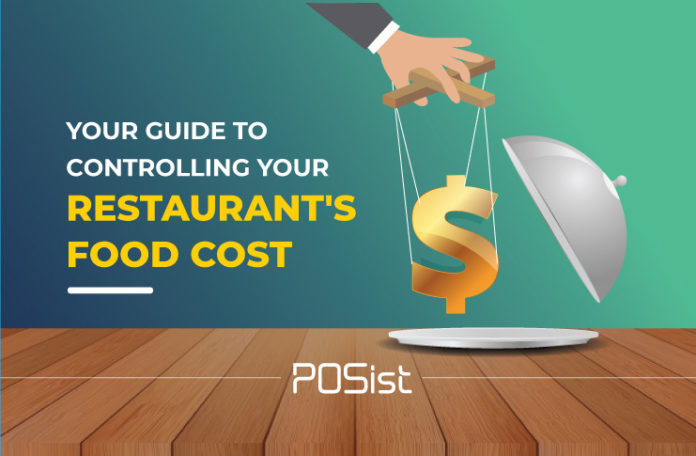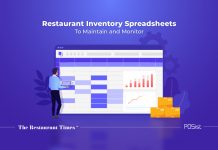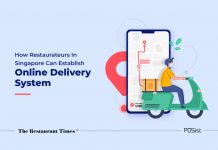The restaurant industry is a cutthroat business where profits are made on razor-sharp lines only. With the way the cost of living has been rising in Singapore, food is getting expensive and as a restaurateur, for you, this means greater food costs and lesser profits. There are a number of hidden restaurant costs in Singapore’s food industry which is heavily dependent on the import of raw materials. A major part of these hidden costs is related to this dependence. In case you are thinking about transferring all the burden of these costs by increasing the menu prices, it would also mean lesser customers. So the question is what can be done? Exercising food cost control is one way to minimize your restaurant costs. Controlling restaurant food costs is imperative for a restaurant business, to survive in the tough F&B industry.
The Food cost is the total cost incurred in preparing a menu item. Food cost is divided into three categories, Maximum Food Cost, Actual Food Cost, and Potential Food Cost.
Maximum Food Cost is the maximum amount that your food costs should reach. Any higher and your restaurant runs a risk of heavy losses. To calculate maximum food cost, first convert all your expenses into a percentage. Then use these formulas:-
100% – (All Expenses%) = Maximum Food Cost %
Maximum Food Cost% X Total Budget = Maximum Food Cost
Actual Food Cost is the food cost that you are running on. To calculate this, use the formula:-
(Opening Inventory + Purchases – Closing Inventory) / Food Sales = Actual Food Cost
If your actual food cost is more than your maximum food cost, the profit margin is less than what you initially planned. If your actual food cost is less than your maximum food cost, then the profit margin is more than what you initially planned.
Potential Food Cost is the minimum food cost that you can have. It is an ideal figure at which there is no wastage whatsoever. Your actual food cost will mostly be more than your potential food cost. Under no circumstances can it be lower than your potential food costs. The closer the gap between your potential and actual food costs, the more your profit. You can calculate your potential food costs by using this formula:-
Total Cost ÷ Total Sales X 100 = Potential Food Cost
Now that you know how to calculate your food cost, next is understanding how you can control it.
How You Can Practise Food Cost Control In Your Restaurant
In order to control your final food costs, there are a number of things that you can do. Some are applicable in any country whatsoever, some, on the other hand, is more geography-specific due to current market trends. Here are some ways to control your food costs is perhaps the most dynamic and tricky restaurant market in the world- Singapore.
1. Menu Analysis
If you want to keep your food costs in check, analyze your menu. Menu analysis means reading between your menu, seeing what works and what does not, analyzing which dish can be let go of, which dish needs to be added, which two dishes share the same base ingredient and so cost less, which dishes cost more to you, etc. By analyzing your menu, you can take important decisions for your restaurant food cost control. You can decide if some dish is a dead burden because it is very slow-moving and let it go. You may also realize that a dish that you had been planning to let go of is actually a fast mover and is generating profits. It helps you in controlling restaurant food costs, by only keeping the high performing items on the menu.
This detailed guide will tell you how to price your menu the right way so that your food costs remain in check.
2. Waste Control
Next is waste control. Managing the amount of waste generated and trying to re-use that waste can seriously decrease your food costs. In a country like Singapore where arable land is limited and most food is imported, waste control in restaurants is a must for controlling food costs. First to manage and reduce waste that is generated, classify the waste in categories. These are:-
- Food returned because it was made incorrectly
- Food spilled or burnt
- Extra portion size
- Food getting spoiled because of lack of consumption
Now that you know what all causes food wastage, you can work on your restaurant’s food cost control by tackling one category at a time.
(i) Food Returned
Make sure that there are no mistakes in the food you send out originally. When a customer returns the food, the measurable loss is limited to the cost of food and the profits loss but actually, there is a greater loss in terms of customer’s trust on your food which will deeply impact his choice of coming back to your restaurant. Be vigilant in the first place and make sure that sub-quality food does not even leave the kitchen grounds.
(ii) Food Spilled or Burnt
As far as the food spilled is concerned, there is little that can be done. Spilling is most common with beverages. For avoiding this, staff training is the key. The food spilled on the kitchen floor may be a fault of the employee but what triggered the fall may just be the state of your kitchen floor. We talk of restaurant equipment management but forget that flooring is the most exploited and least maintained part of the kitchen. Pay attention to the state of your flooring or it may cause more spills than the business can handle. In the case of food getting burnt, again, staff training is the key. You should also invest in good quality equipment so that the food does not get overcooked or burnt.
(iii) Extra Portion Size
Food waste coming from extra portion sizes that get thrown away is a sign that your portion control is off. If one particular dish has a lot of leftover on a regular basis, it means that you are giving too much quantity in the dish. Not only does this hurt the business in terms of food waste but also in terms of the extra cost of raw materials to make that dish.
Last but not least is food waste generated while preparing a dish. When you are preparing the food, there is a lot of chopping which leads to food waste that is simply thrown away. Sometimes the food waste that gets thrown is actually not just edible but can be used for another dish. Efficiently using this waste will decrease the cost of your raw materials as you will be able to produce more dishes from the same ingredient. Moreover, kitchen waste like vegetable peels, bones, etc can be used to make stews which go in various dishes thus making waste management the easiest way to keep your food costs in control and your restaurant within a prescribed budget.
(iv) Food Getting Spoiled Due to Lack of Consumption
Often raw materials end up getting wasted due to non-consumption. This happens when you end of ordering more than required. This is where the need for forecasting arises. Based on the orders you receive in a week or month, you can predict the number of raw materials needed to prepare each item and then order according to that.
Another way to avoid this problem is by setting re-order levels in the Inventory Management System that reminds you to order for more raw materials when a particular item is about to get over. This way, you only order what is required, and also saves you the embarrassment of running out of stock and not being able to serve a particular dish to the customers. The Inventory Management System calculates the number of raw ingredients consumed in preparing the dishes and based on the number of orders received in the POS, gives you the total stock available.
Read this detailed guide on food waste management in restaurants.
3. Inventory Management
As said earlier, the biggest cost draining Singapore’s restaurant industry dry is the cost of ingredients. If you want to control your food costs, just like managing waste, managing inventory is also a must.
You need to keep a track of the items consumed in a day, the number of ingredients consumed in preparing each dish, and the amount remaining at the end of each day. The role of a smart Inventory Management System becomes crucial at this stage.
When you understand which dishes sell the most and what your ordering pattern for these ingredients are, you can tweak the price of the dish and even order bulk quantities of raw material for them to keep costs less. On the other hand, if you notice some ingredients keep getting spoiled and need to be re-ordered again and again, you can determine if this is because you are ordering too much or because the dish is not selling at all. If the dish is not selling because of which ingredients are getting wasted, you can consider adjusting the prices or letting go of the dish entirely.
4. Yield Management
Next is yield management. The number of raw materials you order and the amount that actually goes into making the dish are different. Managing this difference is called yield management. Yield management like inventory management does not directly create a difference but ultimately affects the bottom line of operations and profits. Reducing the amount of edible waste generated through yield management will keep the food costs down. Ordering inventory with the yield of a product also ensures you do not over-order or under order tying inventory management and yield management together when it comes to restaurant food cost control. Yield management is great way of restaurant cost control, it ensures that you are not wasting anything.
5. Portion Control
Food cost control can also come through portion control. As said earlier, controlling portions is necessary to ensure that food costs are minimized. Customers may rejoice in looking at a plate full of noodles but if your portions are too huge, they will ultimately weigh you down as waste will increase. If your portions are too less, the food will not seem worth its cost and you will lose customers. If there is too much waste or uneaten food on the plates coming back in the kitchen or if you are going through your containers too quickly even though the sales are constant, it means that you are over-portioning your food.
Striking a balance is important and maintaining the balance is the key. To ensure that your portions are standardized, you can use techniques like serving from counted spoons, plating using measuring spoons or even tracking the weight of every ingredient in the dish. This article will tell you how to employ portion control at your restaurant.
6. Do More Prep Work
Already prepped for food is expensive. On the other hand, doing some prep work where you will not consume too much time and save your cash when it comes to raw materials. A basic example is this- chopped vegetables are more expensive than regular vegetables. But chopping vegetables will not consume too much time or effort, so instead of buying relatively expensive pre-prepped chopped vegetables, it is more practical to invest in regular vegetables and cut them in-house. Prep work helps in restaurant cost control in a very effective manner, since you know what you need to take care of.
7. Credit Purchases
Up next is credit purchases. Given that you know your inventory and yield of every product to the core, you can save money in the long run by going for credit purchases instead of just cash. Credit purchases are usually discounted bulk purchases. Not only does the discount reduce your cost, the fact that it is bulk means that you can order all your inventory in a single go as compared to ordering it in smaller units using cash.
The restaurant business is a cutthroat one, with one person taking the other over every day. Surviving in this industry is no easy task and in order to survive just making profits is not enough, controlling expenses goes a long way as well. Follow these tips to keep your food costs in control and your profits high, especially in the tricky Singapore F&B Industry.

















